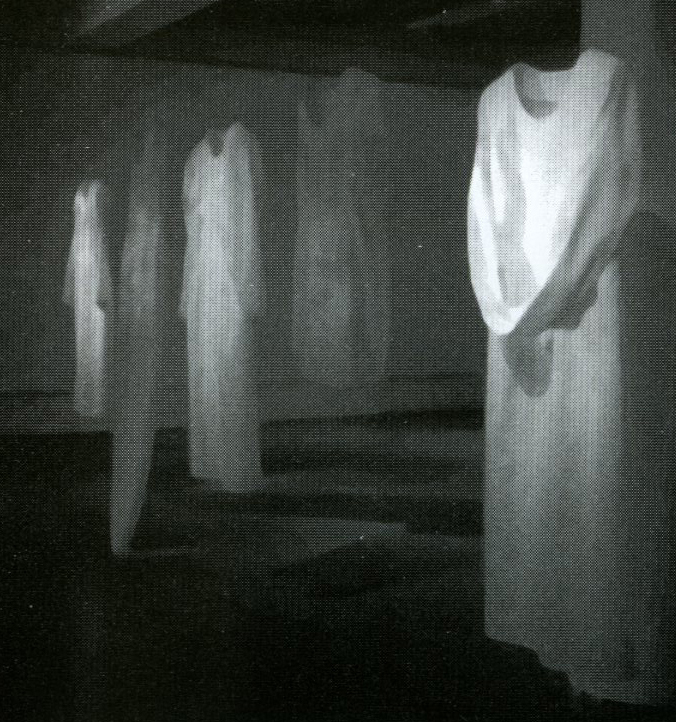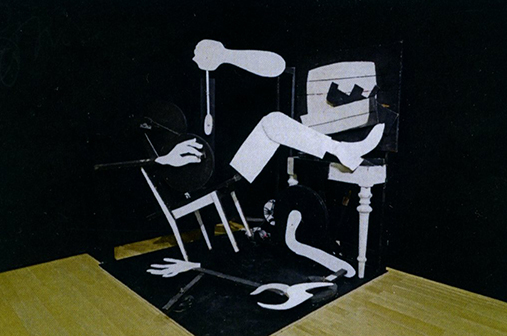


For a period, with the beginning of the 2000s, Södertälje konsthall chosed to focus on painting with at least one exhibition a year. It started with the exhibition Måleriet lever (Long live paintings) which was shown in 2000 (see previous text). The reason was a reaction to a lack of interest that began to be noticed in the 1990s against painting in particular. On the art scene, the focus was on the postmodern tradition, with preference for expressions such as installations, concept art, video. With painting as a new tradition at the art gallery, a strong long-standing collaboration with the municipality’s large art collector Staffan Rasjö was also made possible.
For this exhibition, with the black and white as the theme, three artists were selected. The title The White Side’s Night came from a painting suite with eight black and white paintings on aluminum from the years 2003-2004 by Ann Edholm. In the exhibition folder you can read “The night of the white side could be seen as the dilemma of the author, the artist, the composer. Sleepless nights where a white blank page should be filled with something rich and interesting. But you still do not know what. The night of the white side can also stand for a night without darkness or early dawn between night and day. The final interpretation is in the eye of the beholder… ”
Ann Edholm describes her relationship to painting:
In my painting is the viewer’s
frontal position, body to body,
front view. In the distance look
you picture, the closer you get to the
more, the more the image is resolved to
color, body and painting.
By Lage Lindell, paintings were shown on sheets, guachs and drawings. He started his career in the late 40’s with what was then a bit maliciously called Easter-happy modernism. It was figures and landscapes that mattered, and came to apply throughout life. “Lage Lindell had two sides. One was self-critical. It made him give up image titles, never settle, destroy and move on. For him, painting was an existential attachment point; a way of seeing oneself and perhaps explaining the world. At least a way to look at it. The other side was more swinging and lighter, more akin to the short formulations of jazz./…/Around 1957-58 he began to write his pictures. In a flow as a text. Or improvisation. He drew quickly in his blocks, turned the pages, drew on, and then went in afterwards to explain what he himself had noted. Filled in but gladly left fragments. The rhythm would carry. That’s what an artist who listened carefully to saxophonist Lester Young could do. ”
Another important aspect of Lage Lindell’s art was that he stayed in hospital for several periods of his life. “From memory, he drew scenes that are probably unparalleled. Partly because they are precise in humanity and partly because they are so unsentimental. They became the culmination of his eternal quest to learn to conquer the human form in his images. ”
By Per-Olof Ultvedt, only one work of art was shown, the historical wooden sculpture The Man in the Chair. It was originally included as one of the “creaking, gesturing wooden mobiles” with repetitive movements, by Ultvedt, which was shown in the exhibition Hon-en cathedral, together with Niki de Saint Phalle and Jean Tinguely in 1966 at the Moderna museet. After experimenting with moving scenography together with set designer Lia Schubert, the meeting with Tinguely’s art in Paris in the mid – 1950s became reinforcing to continue on the paved path with moving art.
Sources: exhibition folder, Editor and curator Kristina Möller text Ann Edholm – is the painting faithful, quotes, from the book ANN EDHOLM – BODY AND LANGUAGE, ROOM AND IMAGE, 2012 EDITOR: TOM SANDQVIST, text Lage Lindell – sought an escape line, KC, Texts by Thomas Millroth, b.la. The book about Lage Lindell published by Almlöfs in 2013, text Per-Olof Ultvedt -made playful, mechanical wooden sculptures, KC, (Leif Nylén – The open art) compiled by Anneli Karlsson.